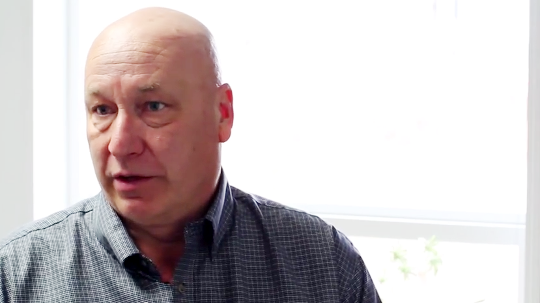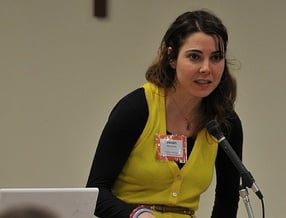
(Image from Morrow Pacific project)
The concept of a bicycling corridor being more important to Oregon than a freight rail connection, an idea which a state committee is likely to validate on Thursday, is drawing sharp criticism from some Oregonians.
“How does a bike/ped project displace a project that benefits multiple regions and benefits numerous businesses? Bike/ped does not belong.”
— Paul Langner, Teevin Brothers
As the state prepares to award $7 million of its $42 million “Connect Oregon” program to projects like the Tualatin River Greenway, some people involved in the process are sharing their dismay in the hope of changes during the next funding cycle.
“A project that will take 5,000 trucks off the highways is not funded, however a project to give bicycles away is scored high,” wrote Paul Langner, a waterfront facility manager for Teevin Brothers in Rainier who sat on both Connect Oregon’s freight and marine modal committees.
Langner was referring, in comments about the process (PDF page 120) to the Oregon Department of Transportation, to two projects that didn’t quite make the cut: his employer’s $2.7 million request for a rail consolidation facility that would gather goods like steel, rebar, cabinets and farm equipment from across the state for rail and barge shipments to Hawaii; and Eugene’s $900,000 request to fund a citywide bike share system, which had scored slightly higher.
“I sincerely question the ODOT economists’ determination of what is statewide significance,” Langner wrote. “How does a bike/ped project displace a project that benefits multiple regions and benefits numerous businesses? Bike/ped does not belong.”
To judge from the comments, the legislature’s decision to include biking and walking projects, a big victory last year for the Bicycle Transportation Alliance, was the most controversial part of this year’s program.
“Figure out how bike/ped qualifies as ‘Statewide Significance,'” one unsigned comment read. “We dwelled on this ad nauseum.”
“There is real concern about spending scarce transportations dollars on bike paths,” said another unsigned comment. “This is a conversation that needs to be take place before ConnectOregon VI occurs.”
I couldn’t call up the anonymous commenters to better understand their views. So I called up Langner. We had a great conversation, excerpted below.
In my circles, people are pretty happy about bike projects getting funded, so I wanted to get your take.
This is just my bullshit opinion, but I’ll give you my two cents.
“If there was a project that built a 10-foot wide path all the way from Portland to Eugene that paralleled I-5, I would personally get money out of my pocket.”
When we started the Connect Oregon program in 2003, the goal was to find alternative methods to fund transportation infrastructure that can’t use the gas tax. Not selected in Connect Oregon V was a project for a company that exports off to Hawaii material that comes from 80 different firms. That project didn’t get funded. Structural steel coming out of Ontario, Ore, rebar that comes out of McMinnville. Farm equipment that comes out of Pendleton, and then specialty projects that come out of Corvallis and out of Portland. According to the application from TriMet for the bike path, a poor struggling company by the name of Nike needed a bike path to get to the MAX station.
The Union Pacific Bridge project in Connect Oregon IV — there wasn’t a lot of jobs created but it took a speed restriction off the railroad bridge. All of a sudden the entire statewide rail system was moving twice as much. Those are statewide significant projects in my little pea brain.
Advertisement
‘Statewide significance’ seems tough to define. But in my own pea brain, it seems like it’s different from just “traveling long distances.” The goal isn’t just to move things around, right? We want to create value.
I really struggle with the regional allocations in Connect Oregon. You get some projects that really really stink. They’re not just dogs – they’re like skunk projects. We funded buses to run around to the hotels and take people to the Indian casinos. Are you kidding me?
I’m not just a freight proponent, but freight is a big piece of it. It’s something that keeps the entire state of Oregon competitive by creating something, especially by enforcing intermodal connectivity – something that has a benefit to Farmer Brown or poor old Jeld-Wen windows. They can actually get a product up to the Port of Portland or the Port of Coos Bay without putting it on the highway.
Were you surprised that the legislature made bike/ped eligible for these grants?
I understand that they’re going to throw something on because that looks good to their constituents. I expected one or two projects to make it. I didn’t expect them to show as well as they did.
But the committees, who are supposed to function as the voice of the people, they were filled with people who say that’s what’s important for the Millennials. Well, yes it is, but what about the intermodal connectivity? “Well they can ride their bike to the bus station.”
I have the feeling that people would say bike/ped is the same as transportation, and you’re really not. Amtrak, public transportation, always gets short shrift. I’d like to see that go further. I can’t get from Rainier, Ore., to the airport by public transportation. But once I get off the plane in Amsterdam, I can grab the commuter train that runs off to Antwerp, meet my friend there and have a beer without touching a car.
But that’s just the thing, right? Antwerp has a lot more people than Longview-Rainier. I used to live in Longview, and it seemed to me that the area has had a really rough 30 years. Since then, the way I think about the U.S. economy is that we’re just not going to make stuff any more, we’ve got to make ideas. So the way to benefit the economy is to make places really nice, so people will choose to live there.
We’re not that far apart. I do see the value in livability, and bike/ped is an important piece of it. But it needs to have some sense of connectivity. The City of Rainier takes ODOT money for road projects, and when we do, we have to install a bike lane. So here’s a bike lane that’s five blocks long. The upwards end doesn’t connect anything to the downwards end.
If there was a project that built a 10-foot wide path all the way from Portland to Eugene that paralleled I-5, I would personally get money out of my pocket.
——

(Photo: J. Maus/BikePortland)
After talking to Langner, I spoke to his counterpart Susan Peithman, a former BTA staffer who also sat on several Connect Oregon committees and supports funding for bike projects.
Pethiman agreed that now that biking and walking projects are competing directly with different modes for the first time in decades, biking supporters need to get better at making the case for “statewide significance.”
“We had been operating in a marginalized space and we asked to sit at the big table,” Peithman said. “And we did. And we fared well. And there’s going to be more backlash because there’s going to be more people looking at what we’re doing. … So we have to bring our A game. No bones about it. Good projects and good arguments.”

